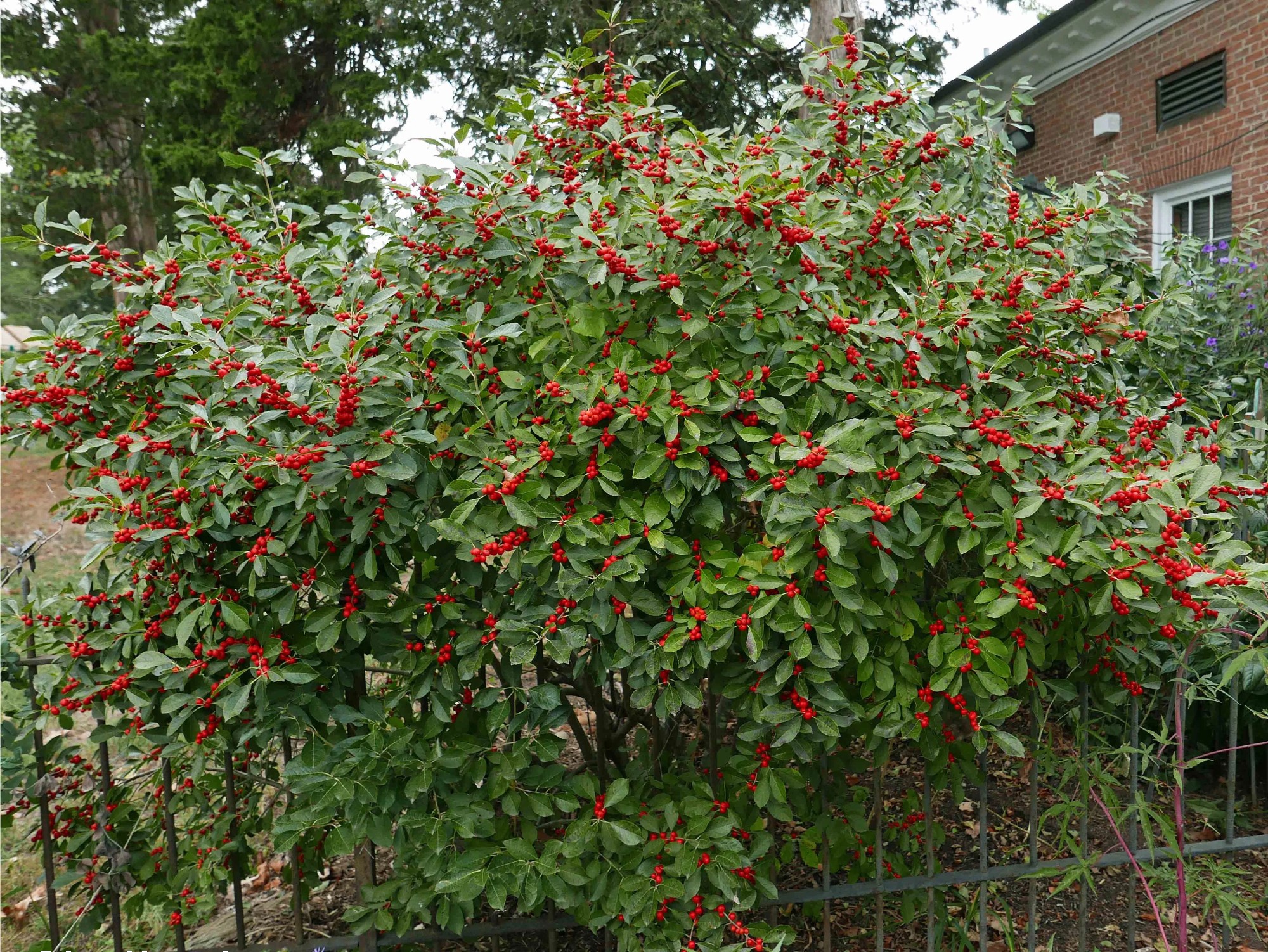Ilex verticillata: 'Winterberry Holly'
Latin name: Ilex verticillata
Common name: Winterberry Holly
Flowers: Not showy 15
Fruit or cones: Showy 12
Height & Width: 3-12’ h x 3-12’ w 4
Type: Deciduous shrub 12
Habit: Oval, rounded, but twiggy; multi-stemmed 4
Wetland indicator category**: FACW 17
Texture: Fine 15
Growth rate: Slow to moderate 4
Light: Full sun to part shade 12
Moisture: Medium to wet 12
Soil*: Prefers moist, acidic, loamy soil, but adapts to other soil types. Does not tolerate alkaline (high pH) soils 4
Zones: 3-9 12
Origin: Native to North America 15
Ecosystem benefits: Serves as a larval host for Henry’s Elfin butterfly and also attracts butterflies and bees. Bees are important pollinators of winterberry flowers. Wildlife also use this shrub for cover and nesting, and the berries serve as a food source for birds during the fall and winter 4

Features: Berries are beneficial for wildlife and a favorite of at least 12 bird species. The foliage hosts larvae of Henry's Elfin butterfly, Spring Azure butterfly, and Harris’ Three-Spot moth. Winterberry also supports woolly aphids that are preyed upon by Harvester butterfly larvae 20.
Siting: The native habitat of winterberry ranges from plant colonies along the edges of streams or ponds and in, or near, swamps, thickets, and low woods. Due to root suckers, it will naturally form thickets or colonies when planted in a garden with consistently moist soil. Winterberry is best used en masse and grouped plantings in shrub borders or foundation plantings 4.
Care: Plant so root flare is visible at soil surface 14. At planting, water the root ball daily with two gallons of water per inch of trunk diameter for two weeks, every other day for two months and then weekly until established. Modify water recommendations to reflect site drainage and rainfall. Apply 3” of mulch over the planted area. Do not allow mulch to touch the trunk 14. For the best berry display, plant male and female plants together. Because winterberry plants are bee pollinated, generally one male plant is recommended for every four to five female plants (if plants are relatively far apart). If plants are closer together (within 40 feet) one male plant may be adequate to pollinate up to 20 female plants 4. Prune to shape early in the season before new growth appears 4.
Pests: No pests or diseases are serious 15.
This plant does not appear on the following invasive plant lists on (4-11-21):
- USDA SC Invasive Plant Species Web site at http://www.invasivespeciesinfo.gov/plants/main.shtml
- SC Exotic Plant Pest Council Web site at http://www.se-eppc.org/southcarolina/
Author: Braden Martin
Image source: https://mgnv.org/plants/shrubs-2/winterberry/
Sources:
- Armitage, A. (2001). Armitage’s manual of annuals, biennials, and half-hardy perennials. Portland, OR: Timber Press.
- Armitage, A. (2006). Armitage’s native plants for North American gardens. Portland, Oregon: Timber Press.
- Armitage, A. (2008). Herbaceous perennial plants: A treatise on their identification, culture, and garden attributes. Athens, GA: University of Georgia.
- Clemson Cooperative Extension Home and Garden Information Center.(2011). Flowers fact sheets. Retrieved from https://hgic.clemson.edu/category/flowers/
- Clemson Cooperative Extension Home and Garden Information Center.(2011). Groundcovers & vines fact sheets. Retrieved from https://hgic.clemson.edu/category/groundcovers/
- Clemson Cooperative Extension Home and Garden Information Center.(2011). Trees. Retrieved from https://hgic.clemson.edu/category/trees/
- Clemson Cooperative Extension Home and Garden Information Center.(2011). Shrubs. Retrieved from https://hgic.clemson.edu/category/shrubs/
- Dirr, M. A. (2009). Manual of woody landscape plants. Champaign, IL: Stipes Publishing.
- Gilman, E. F. (1997). Trees for urban and suburban landscapes. Albany, NY: Delmar Publishers.
- Lady Bird Johnson Wildflower Center University of Texas at Austin. (2012). Native plant information network. Retrieved from http://www.wildflower.org/explore/
- McMillan, P., Plant taxonomist Clemson University, personal communication.
- Missouri Botanical Garden Kemper Center for Home Gardening. Plant finder. Retrieved from http://www.mobot.org/gardeninghelp/plantfinder/Alpha.asp
- North Carolina State University (2005). Plant fact sheets. Retrieved from http://www.ces.ncsu.edu/depts/hort/consumer/factsheets/index.html
- Strother, E. V., Ham, D. L., Gilland, L. (2003) Urban tree species guide: Choosing the right tree for the right place. Columbia, SC: South Carolina Forestry Commission.
- University of Florida, IFAS Extension. (2011). Southern trees fact sheet. Retrieved from http://edis.ifas.ufl.edu/department_envhort-trees
- USDA . Plant profile. (n/d).Retrieved from http://plants.usda.gov/java/
- USDA. Plant wetland indicator status. (n/d). Retrieved from http://plants.usda.gov/wetland.html
- Vincent, E., Environmental horticulturist Clemson University, personal communication.
- Clemson Extension. Carolina Yards Plant Database. Retrieved from https://www.clemson.edu/extension/carolinayards/plant-database/index.html
- Habitat Avengers Featured Native Plant: Ilex verticillata https://bugwoodcloud.org/CDN/sceppc/publications/WinterberryArticleSCNLA.pdf
*Soil pH is determined using a professional soil test. Contact your Clemson University County Extension service for assistance www.clemson.edu/extension/. Click on “local offices”.
**2012 Plant Wetland Indicator categories (quantitative derived) http://plants.usda.gov/wetinfo.html
|
Indicator Code |
Indicator Status |
Comment |
|
OBL |
Obligate Wetland |
Almost always is a hydrophyte, rarely in uplands |
|
FACW |
Facultative Wetland |
Usually is a hydrophyte but occasionally found in uplands |
|
FAC |
Facultative |
Commonly occurs as either a hydrophyte or non-hydrophyte |
|
FACU |
Facultative Upland |
Occasionally is a hydrophyte but usually occurs in uplands |
|
UPL |
Obligate Upland |
Rarely is a hydrophyte, almost always in uplands |
